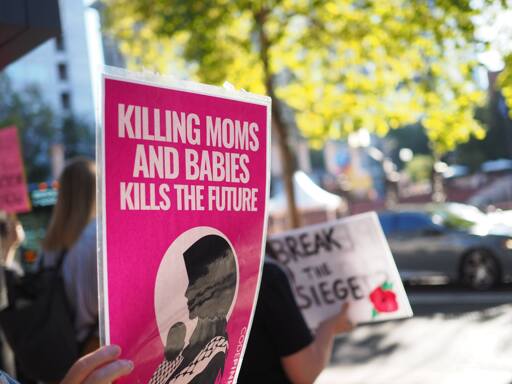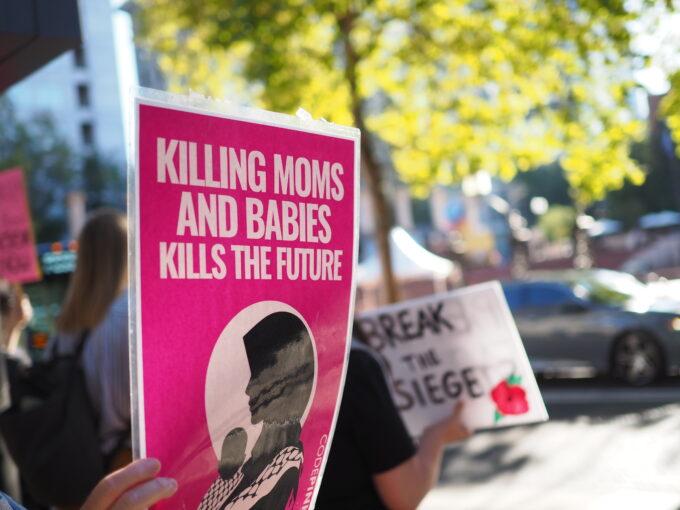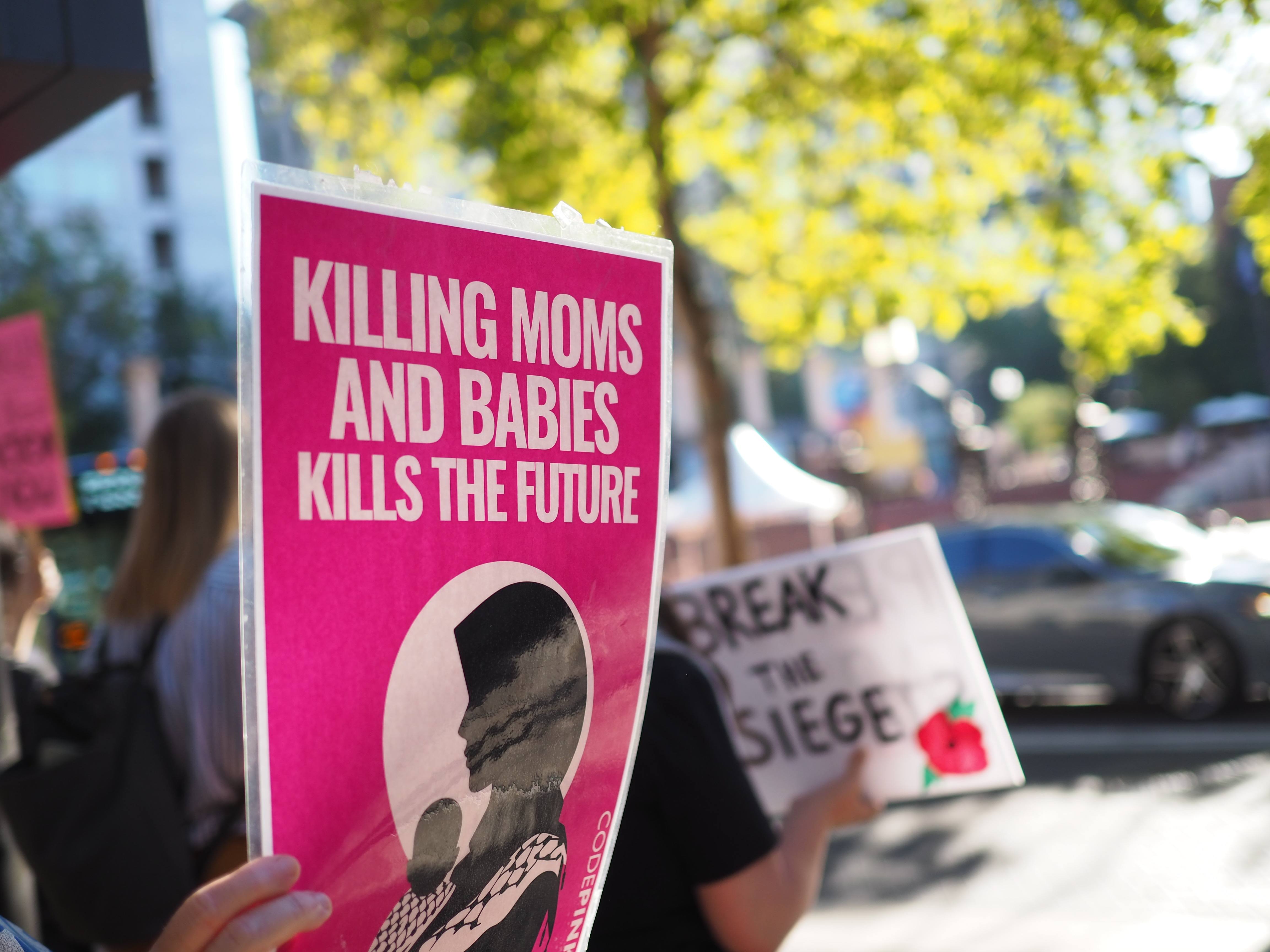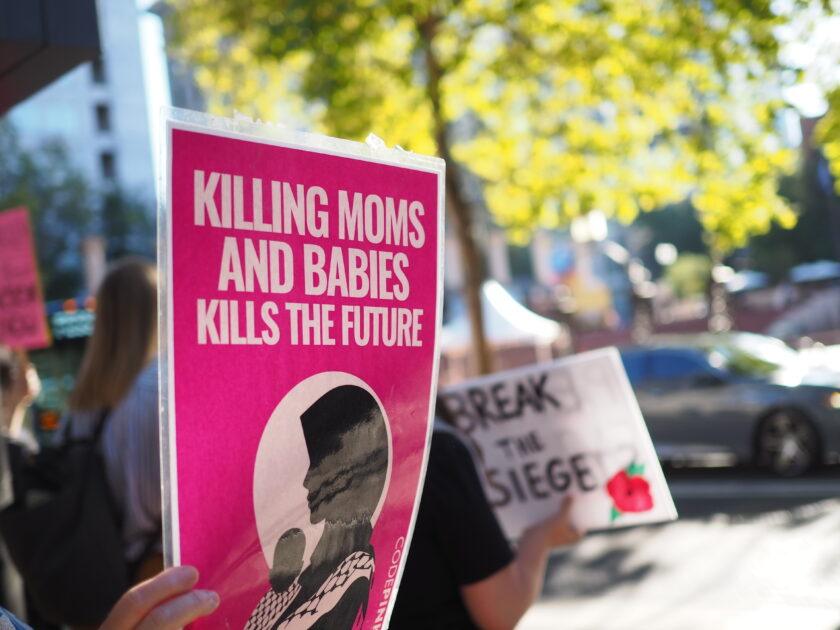Photograph by Nathaniel St. Clair
Note: At the time of writing, a summary analysis similar to the one below was published Current Affairs, attributed to “Lex Syd.” There are a few differences in our sources and analyses, but the numbers are the same.
For a year and a half, whether we’ve noticed it or not, people who look at international news have read variations on the following sentence many, many times: “The Gaza Ministry of Health does not distinguish between civilians and combatants.” Its inclusion is so mindlessly automatic at this point that it keeps showing up in major media’s occasional articles on how many children the Israeli Defense Forces have killed, an obscene caveat suggesting that for all we know, most of these kids—even most of the pre-teenage kids—were justified targets.
It has made some sense to rely on the Ministry’s count as a baseline death toll, since it only includes recovered bodies, most of them identified by name. This is why every country, U.N. organization, international humanitarian organization, and mainstream media outlet uses it—even Israeli intelligence agrees with its numbers. But given the shocking pace at which the death toll in Gaza has climbed, it has seemed to genocide skeptics to demand a qualifier. So, early on in the war on Gaza, the “does not distinguish” sentence became an editorial incantation allowing a measure of disbelief in the livestreamed reality of the mass killing of civilians.
This obsession with ambiguity was at once very human — who wouldn’t prefer to see a reality where we weren’t complicit in a genocide? — and deeply inhuman, in its rote soft-pedaling of atrocities in which all Americans, as their primary suppliers and chief international supporters, have always been complicit. If the unbelievable numbers of unarmed people killed by one of our closest allies, with the active support of our own country—5,000 of them, and then very quickly 10,000, and 25,000, and then 30 and 40 and 60,000 people just like us and our families—if an indeterminate number of them were actually “combatants,” well, maybe this was was only, as so many supporters of the war on Gaza kept saying, the storm and fog of just another war. After all, the IDF had estimated, as the siege of Gaza began, that there were some 30,000 Hamas fighters in Gaza. Maybe a 30%, or a 40%, or even a 50% civilian death rate, many people apparently thought, was just the price that had to be paid for the realization of a fantasy that no one ever really believed was possible—the “eradication” of Hamas.
Wherever one has stood in relation to this open-ended spectrum of horror, the Ministry numbers have seemed to be something everyone could pretty much agree on, at least within the fringes of the discourse on Gaza. Unless you were so rabid to keep the death machine rolling that your first instinct was to call the unspooling names of dead children “Hamas propaganda,” or you were so certain that we were being forced into complicity in a genocide that you obsessively recalculated and posted the most probable real death toll (as I’ve done every month since the siege began), you saw the visible consensus: however many thousands, “according to the Gaza Ministry of Health, which does not distinguish between civilians and combatants.”
Yet virtually everyone who accepts that number also accepts that it must be an undercount of some significant but unknowable size. Since the Health Ministry only counts recovered bodies, every single unrecovered body is also uncounted. When we recall what the damage in Gaza looks like—massive bombs dropped on densely populated urban areas, generally with no actionable warning, usually with vague or expired location data and often without guidance systems anyway—it’s hard to avoid the question of how many people have died, quickly or in prolonged agony, whose bodies have never been recovered. Imagine for a moment that the greater New York metropolitan area were reduced to this, with virtually no one allowed to leave as it happened, nowhere to shelter, and with further bombing of the areas to which any internal refugees relocated, and you can begin to imagine how many human beings were hit so hard that there was nothing left to recover or identify; how many more could never be recovered, brought in to be identified, or counted; how many bodies were buried either anonymously, in cemeteries since razed flat by the IDF, or in the mass graves it has dug; how many families had no members left alive to report the dead.
As Arwa Mahdawi put it in The Guardian last week, “We have no idea how many people have been killed in Gaza but I would bet my own life that the number is far higher than the 60,000 number the media uses.” That’s a very common thought in discussions of Gaza. There’s even a very occasional qualifier to the “does not distinguish” clause in major media coverage, noting that the Ministry’s death toll is “likely to be an undercount.”
The problem with leaving this sentiment at “we have no idea how many people have been killed” is that we do have a very clear idea of the minimum, based on the most rigorous, detailed analyses that statisticians, epidemiologists, and experts on urban warfare, working together under stringent peer review in the world’s leading research forums, agree on. And that minimum number is indeed much higher than the Ministry’s count.
That minimum scientifically plausible number of traumatic deaths only—immediate deaths from bullets, bombs, and demolished buildings—in the Gaza genocide is currently more than 115,000.
The minimum scientifically plausible number of deaths attributable to the genocide overall is more than 460,000.
Anyone who claims to rely on the best scientific consensus today must report the current death toll in the Gaza genocide as “more than 115,000” violent deaths or “more than 460,000” overall.
Here, in detail, is why.
The Gaza Ministry of Health’s death toll as I write this has just passed 62,000—I’ll refer to this number as “GMH,” so anyone can easily replicate this math at any point in the future. Here are the steps, with citations, for understanding this number’s relationship to the current 115,000-460,000 range. In every step, I will use the most conservative plausible parameters of any uncertainly, ensuring that our minimum really is the minimum.
- The first adjustment that must be made to this number is the Ministry of Health’s likely undercount, due to the sheer chaos of the genocide. The definitive scientific study calculating this number was published in February 2025 by four of the world’s leading clinicians, epidemiologists, and experts in emergency medicine, in The Lancet—a 200-year-old, rigorously peer-reviewed scientific journal and the world’s most prominent research publication in general medicine. The researchers, the research, and the venue here are unimpeachable, and its results have since been confirmed nearly exactly by a second major study using a completely different approach. The study found, with a 95% confidence interval, that the Ministry undercounted the death toll from traumatic injury by 41%. This means that the Ministry’s count at the time represented only 59% of the actual deaths due to traumatic injury. It is almost certainly more of an undercount now, since reporting conditions have only deteriorated in the more than 13 months since the end of the period considered in the study—but we will stay with the minimum plausible number.
For this, we need to divide GMH / .59*, for a minimum of 105,085 deaths by traumatic injury.*
- The calculation of this undercount excludes those who are missing and presumed dead.
A second adjustment must be made for the number of Palestinians whose bodies have gone unretrieved. That calculation has remained more or less set, by organizations including the U.N. Office for the Coordination of Humanitarian Affairs and the Lancet study, since at least May 2024, at about 10,000.
It is almost certainly much higher: ever more buildings have been bombed and demolished, and no heavy equipment capable of digging out bodies has been allowed to operate. An indeterminate number of others were shipped to Israeli prison camps to be imprisoned without charges and frequently starved, beaten, and/or sexually or medically tortured. An unknown number of these Gazans have also been killed, their bodies dumped on the ground back in Gaza to be identified or not, or buried or stored in Israeli territory, their names often unrecorded and rarely reported.
But again, we’ll go with the consensus minimum: 10,000.
GMH / .59
+10,000
The current minimum death toll in the Gaza genocide is now 115,085—our overall minimum number for deaths by traumatic impact alone.
- This number does not include anyone killed in the genocide by any means other than traumatic violence leading directly to death (though we can be sure that many thousands of those actually suffered in the worst imaginable pain and despair beneath the rubble, or in the street, or on a bombed-out hospital floor, for some time before dying).
If we want to include Gazans killed by other siege tactics—Israel’s strategic denial of food, water, medical supplies, power, and medicine—we must rely on data from previous bombing and siege campaigns with similar profiles. This is challenging in part because the Gaza genocide is genocidal: because only a tiny fraction of Gazans have been allowed to leave Gaza, and because the IDF has ensured a civilian casualty rate that vastly exceeds that of comparable bombardments, and because no bombing campaign has been as proportionately destructive since or even before World War II, the scope of “excess mortality” compared to the death rate before October 2023 may be so large that there is nothing in the historical data to help us estimate a probable maximum.
But again, let’s set the minimum.
The Lancet followed up its initial study by publishing a letter from three other internationally respected doctors and epidemiologists pointing out that according to extensive studies of recent wars compiled by the UNHCR, the ratio of “indirect deaths” to direct deaths from traumatic impact ranged from 3:1 to 15:1. It’s worth emphasizing once again that the bombing campaign in Gaza has been far more destructive than any of the wars that yielded these ratios. Nonetheless, we will take the smallest recorded ratio of 3:1—even less than the 4:1 ratio that the UNHCR study uses as its most “conservative” metric.
GMH / .59
+10,000
x3
The minimum death toll in the Gaza genocide is now 463,220—our minimum number of deaths directly attributable to the genocide.
These numbers, which represent the most conservative minimum that is scientifically plausible in each case, can now be used as a baseline for further calculations based on other data:
Before October 2023, the population of the Gaza Strip was about 2.23 million. Direct deaths from the genocide have killed at least 5% of the population. Direct and indirect deaths from the genocide have killed at least 20% of the population.
Given Israel’s own estimate that there were some 30,000 Hamas fighters in Gaza as of October 2023, of which it now says it has killed some 20,000 (it has provided no evidence for either figure), the civilian death rate it has inflicted through direct deaths is more than 83%. The overall civilian death rate it has inflicted in Gaza since October 2023 is at least 96%.
Before October 2023, children under 15 years old represented 44% of Gaza’s population. The Hamas fighters that Israel claims to have killed are a statistically negligible part of that population. The Lancet study found 59% of direct deaths to be those of women, children, and the elderly—excluding military-age men. Basic demographics show that 66% of that 59% were children under 15. The direct death toll for children under 15 in this genocide is at least 45,221. The death toll for children under 15 including all deaths caused by the genocide is, at minimum, 135,664—and almost certainly many more.
There will be no way to accurately count the dead in Gaza until the bombing ends. Even then, it will take years. Nonetheless, we can bear better witness than the repetition of the baseline numbers tallied by the Gaza Ministry of Health; and we can bear far better witness than to recite, like a talisman, that it “does not distinguish between civilians and combatants.”
We can—we must—start acknowledging the bare minimum of what this genocide has already, indisputably wrought.
The post The Real Gaza Death Toll is Impossible to Know Today, But the Minimum Isn’t appeared first on CounterPunch.org.
From CounterPunch.org via this RSS feed






